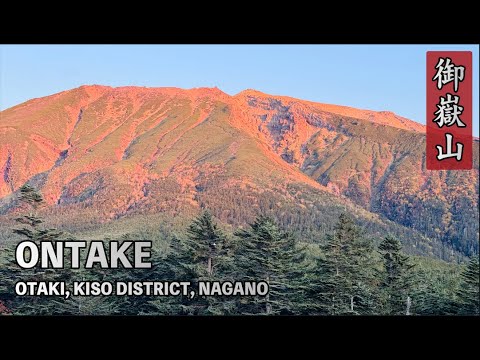Ontake 御嶽山 – Sacred Mountain (Major) – Nagano, Gifu – 10/11/2024
My Experience: As my first hike of my 2024 hiking season, there were some positives and negatives. I arrived back in Japan on October 7th with the first 3 days raining. Eager to get started hiking and enjoying the outdoors, I loaded up the van and headed out the evening of the 10th, sleeping in the van until the following morning. More at https://volcanicjapan.com/my-experience-guide/f/ontake-%E5%BE%A1%E5%B6%BD%E5%B1%B1—major-sacred-mountain—nagano-gifu—10112024
About:
Volcano No. – E66
Volcano name – Ontake San
Geologic code – Q3m
Main activity period – Chibanian (Middle Pleistocene) – Holocene
Activity period / recent activity – From 0.78 Ma.
Latest eruption – AD 2014
Volcano type Composite (compound) volcano – Caldera, Composite (compound) volcano
Representative rock type – Intermediate
Main rock type – Basalt, Andesite, Dacite, Rhyolite
Height above sea level – 3067 m (Kengamine)
Location (Prefecture) – GIFU, NAGANO
Record of eruption & disaster
– 14 Sep 1984: Debris avalanche caused by flank collapse due to the Nagano-ken Seibu Earthquake (“Ontake-kuzure”). 29 fatalities.
– May 1991: Small phreatic eruptions (Jigoku-dani): Ash fallout only around the crater.
– Mar 2007: Small phreatic eruptions (Jigoku-dani): Ash fallout only around the crater.
– Sep 27 2014: Phreatic eruption (Jigoku-dani): Ash fallout. Pyroclastic flow. 63 fatalities and missing people.
(Source: GSJ)
About: Mount Ontake (御嶽山, Ontake-san), also referred to as Mount Kiso Ontake (木曽御嶽山, Kiso Ontake-san), is the 14th highest mountain and second highest volcano in Japan (after Mount Fuji) at 3,067 m (10,062 ft). It is included in Kyūya Fukada’s 1964 100 Famous Japanese Mountains. Mt. Ontake is located around 100 km (62 mi) northeast of Nagoya, and around 200 km (125 mi) west of Tokyo, at the borders of Kiso and Ōtaki, Nagano and Gero, Gifu. The volcano has five volcanic crater lakes, with Ni no Ike (二ノ池) at 2,905 m (9,531 ft) being the highest mountain lake in Japan. Ontake is a major sacred mountain, and following shugendō practices, actors and artists have gone to the mountain to put themselves into trances to get divine inspiration for their creative activities.
Ontake was thought to be inactive until October 1979, when it underwent a series of explosive phreatic eruptions which ejected 200,000 tons of ash, and had a volcanic explosivity index (VEI) of 2. There were minor non-explosive (VEI 0) phreatic eruptions in 1991 and 2007.[5]
On Saturday, September 27, 2014, at around 11:53 a.m. Japan Standard Time (UTC +9), the volcano erupted with a VEI of 3. There were no significant earthquakes that might have warned authorities in the lead up to the phreatic eruption—caused by ground water flashing to steam in a hydrothermal explosion. The Mount Ontake volcano eruption was an extremely rare phenomenon which made it difficult to take precautionary measures. At the time of the eruption, several hiking parties were undertaking ascents and descents of Ontake, with emergency descents having to be undertaken in the presence of ash clouds and falling rocks. 63 people were killed; five bodies were never found. The Japan Self-Defense Forces began carrying out helicopter searches for missing people after the eruption. (Source: Wikipedia – Mount Ontake)
Geological Summary: The massive Ontakesan stratovolcano, the second highest volcano in Japan, lies at the southern end of the Northern Japan Alps. Ascending this volcano is one of the major objects of religious pilgrimage in central Japan. It is constructed within a largely buried 4 x 5 km caldera and occupies the southern end of the Norikura volcanic zone, which extends northward to Yakedake volcano. The older volcanic complex consisted of at least four major stratovolcanoes constructed from about 680,000 to about 420,000 years ago, after which Ontakesan was inactive for more than 300,000 years. The broad, elongated summit of the younger edifice is cut by a series of small explosion craters along a NNE-trending line. Several phreatic eruptions post-date the roughly 7300-year-old Akahoya tephra from Kikai caldera. The first historical eruption took place in 1979 from fissures near the summit. A non-eruptive landslide in 1984 produced a debris avalanche and lahar that swept down valleys south and east of the volcano. Very minor phreatic activity caused a dusting of ash near the summit in 1991 and 2007. A significant phreatic explosion in September 2014, when a large number of hikers were at or near the summit, resulted in many fatalities. (Source: Global Volcanism Program)
#japanese #japantravel #volcano #volcanic #onsen #hotsprings #hike #travel #travelvlog #japanvlog #japaneseculture #volcanohikes #volcanotreks #hokkaido #gunma #nagano #miyagi #yamagata #niigata #iwate #aomori #akita #fukushima #shizuoka #oita #kumamoto #kagoshima #nagasaki #mammut #arcteryx #gopro #djiair3 #dji #montbell #hiking #ontakesan #mountontake #naganoprefecture #nagano #gifujapan #gifu #gifuprefecture

